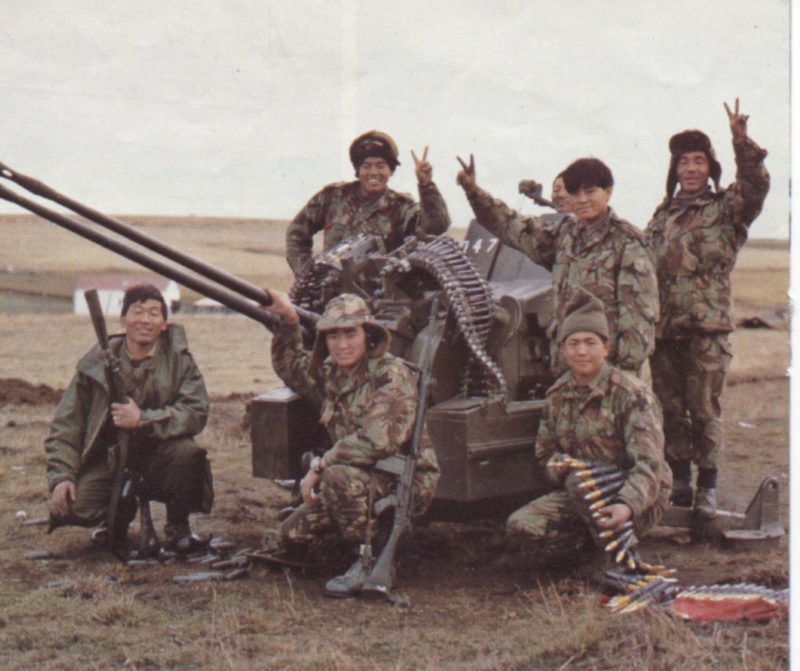Gurkhas and the Falklands War

Gurkhas and the Falklands War
Operation CORPORATE
Attempting to assert sovereignty over the disputed islands, on the 2nd April 1982 Argentinian troops invaded the Falkland Islands. After the initial shock, the British Government reacted quickly. Assembling a Naval Task Force which set sail within days. Gurkhas played a key role in retaking the Falkland Islands.
1st Battalion 7th Duke of Edinburgh’s Own Gurkha Rifles (1/7 GR) was the UK-based Gurkha Battalion at the time and part of 5 Infantry Brigade. They would subsequently be added to the Task Force Order of Battle for Operation CORPORATE, the retaking of the Falklands. Rapid preparations for departure were made at the battalion’s base in Church Crookham. This included integrating new equipment, radios and additional heavy machine guns.
By early May most pre- deployment training had been carried out. On May 12th at Southampton, 1/7 GR with four members of 541 Troop, Queen’s Gurkha Signals, embarked on the liner Queen Elizabeth 2. The Battalion continued to train whilst onboard ship and also celebrated the Battalion’s 80th Birthday, despite the confines of a 21-day sea voyage.
Gurkhas arrive at the Falklands
The Battalion arrived on the north of the island at San Carlos Bay on June 1st. Landed. ‘D’ Company of the Battalion was left to defend the landing site, while the remainder of the Battalion was flown forward in a series of helicopter lifts. Heading south to Goose Green they relieved 2nd Battalion the Parachute Regiment and took over guarding roughly 500 Argentinian prisoners.
Once their prisoners were moved on, the Battalion turned to a series of aggressive patrols across Lafonia (the southern half of East Falkland). One patrol took prisoner a group of Argentinian soldiers, commanded by an officer and armed with anti-aircraft weapons, simply by brandishing a khukuri in a threatening manner. Having moved on foot from their positions near San Carlos to Goose Green, ‘D’ Company re-joined the rest of the Battalion. The Company completed the move in less than 36 hours, despite some of the men carrying in excess of 140lb.
Gurkhas under attack
By June 9th the Battalion had moved east to Fitzroy. The following day plans were laid for an attack by 5 Brigade towards Mt Tumbledown and Mt William. As the Battalion moved towards its assembly area for the attack it came under sporadic but accurate artillery fire. On June 11th, four members of ‘B’ Company were wounded by shrapnel and were evacuated. The Battalion was to cooperate with the Scots Guards, moving along a feature known as Goat Ridge to attack and take Mt William from the north. This attack would have to be completed in darkness and involve moving through areas almost certainly mined.
Delays to the start of the attack meant that it was daylight on June 14th before 1/7GR began to move. They soon came under more Argentinian artillery and mortar fire. The Battalion suffered a further eight casualties, two of which were serious. Despite this being the first time the men had been under fire, their reaction was stoic. Captain (QGO) Bhuwansing Limbu, the 2iC of ‘D’ Company stated, ‘jolly exciting this, isn’t it?’ to his Company commander.
Gurkhas in the Falklands – Argentinian Surrender
Despite the delays, mortar fire and occasional accurate sniping from the enemy, D Company began its advance towards its objective of Mt. William. A large number of Argentinian soldiers had begun to either surrender to the Scots Guards nearby or rapidly withdraw to Port Stanley. It is believed that the Gurkhas’ reputation had caused panic in the enemy when they realised who they were facing. It soon became apparent that the Argentinians were fully surrendering and the war was coming to a close.
All Argentinian forces on the Falklands surrendered later that day.
Gurkha casualties in the Falklands
After another couple of nights in the hills around Port Stanley the Battalion moved back to Goose Green. Here on June 24th, the Battalion’s suffered its only fatality. Lance-Corporal Budhaprasad Limbu was killed after his spade struck an active grenade whilst clearing the former battlefield. He would be one of only two Gurkha soldiers killed as a result of the Falklands War. The other, Corporal Krishnakumar Rai of the Queen’s Gurkha Engineers, was killed in an ordnance explosion during clean-up operations later in 1982.
The Battalion remained in the Falklands to assist in returning normality to the local population and to utilise the islands for further training. Finally, the main body of the Battalion returned to the UK on the SS Uganda. First docking at Southampton the Battalion then arrived back in Fleet to a spectacular welcome on August 9th. This was just ninety days after their departure.
Learn more about the Gurkhas in the Falklands with our online exhibition.

